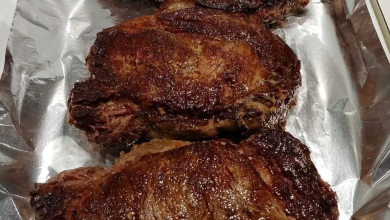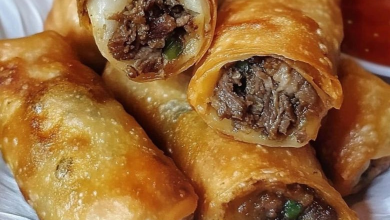What Happens When You Eat Expired Cans!


The Truth About Expired Canned Food: Why Dates Don’t Always Mean It’s Bad
Hidden behind jars of pasta sauce and bags of rice, most pantries hold a few forgotten cans — beans, soup, or vegetables pushed to the back for years. When they’re finally found, the instinct is almost always the same: check the date, see it’s long expired, and toss it. But here’s the truth — most “expired” canned foods are still perfectly safe to eat. Those printed dates rarely mean what we think they do. Understanding that difference can save money, cut down on waste, and challenge a few long-held kitchen myths.
The Real Meaning Behind Expiration Dates
Food labeling is often confusing by design. Phrases like “Best By,” “Best Before,” and “Use By” are not standardized expiration dates but simply manufacturer suggestions for peak quality.
- “Best By” or “Best Before” marks the period when a product tastes and looks its best. After that, it may lose some flavor or texture but remains safe to eat.
- “Use By” is mostly used for perishable items such as milk, deli meats, or juices. Even then, it’s a guideline for quality — not an immediate safety cutoff.
For canned foods, these labels act more like marketing tools than warnings. A can doesn’t suddenly become unsafe the day after the printed date. According to the U.S. Department of Agriculture (USDA), properly stored canned foods can remain safe for years — even decades.
The Science of Longevity
A can’s impressive lifespan comes down to the preservation process. The food inside is cooked in its sealed container at high temperatures, killing bacteria and creating a vacuum that prevents new microorganisms from entering. As long as that seal stays intact, the contents remain protected from spoilage.
Storage conditions, not printed dates, determine how long canned goods last. A cool, dry, and dark place — ideally under 85°F (29°C) — can keep cans fresh well beyond their labels. Heat and humidity, on the other hand, can corrode metal, weaken seals, and slowly degrade the food inside.
Different types of canned foods also age differently:
- High-acid foods (like tomatoes, pineapple, and citrus) typically last 12–18 months. Their acidity helps inhibit bacteria but can gradually wear down the can’s lining.
- Low-acid foods (like beans, corn, peas, carrots, potatoes, and canned meats) can last three to five years, often much longer.
With proper storage, even a can that’s been sitting quietly for a decade can still be edible.
When “Expired” Doesn’t Mean Unsafe
A passed “Best By” date doesn’t automatically mean the food has gone bad — it simply signals a decline in quality, not safety. If the can looks normal — no rust, bulging, dents, or leaks — the food inside is likely fine.
When opening older cans, trust your senses:
- Look: The color and texture should appear normal.
- Smell: Any sour, rancid, or metallic odor means it’s time to toss it.
- Taste (with caution): If it looks and smells fine, test a small bite. A metallic or “off” flavor means it’s better discarded.
Even when past their date, most canned goods remain safe and nutritious — though taste and texture may fade slightly. Green beans may lose their snap, or soup might taste a little dull, but they’re still perfectly edible.
The Real Danger Signs
While most cans last for years, some damage can make them unsafe. Always discard cans that show:
- Bulging: A sign of gas buildup, often caused by bacteria such as Clostridium botulinum (which causes botulism).
- Leaking: Any sticky or discolored residue means the seal has failed.
- Deep rust or dents along seams: These can break the airtight barrier.
- Foul odor or fizzing when opened: Indicates bacterial activity — throw it out immediately.
Botulism, though rare, is serious and can be deadly. If a can looks or sounds suspicious when opened — bulging, hissing, or leaking — it’s not worth the risk.
How to Store Canned Goods Safely
To keep your canned foods fresh and safe for as long as possible:
- Store them in a cool, dry place away from heat and humidity.
- Follow the “first in, first out” rule — use older cans before newer ones.
- Inspect periodically for rust, swelling, or dents.
- Avoid storing near stoves, dishwashers, or heaters where temperatures fluctuate.
With proper storage, canned food can remain safe for decades — even if flavor and color eventually fade.
The Problem With Food Waste
Every year, millions of tons of food are discarded because of confusion over date labels. Over 80% of consumers believe “Best Before” means “unsafe after,” but it only refers to taste and quality.
This misunderstanding leads to massive waste — especially of canned foods, which are among the most durable items in the pantry. Learning how to read and interpret those dates helps reduce waste, save money, and promote sustainability.
The Bottom Line
Canned food is one of the safest and most reliable preservation methods ever created. As long as the can is intact and stored properly, the contents can remain safe for many years — sometimes even decades — beyond the printed date.
Next time you discover an old can of beans or soup in your pantry, don’t toss it out automatically. Check the condition, trust your senses, and make an informed choice.
Understanding how canned preservation really works doesn’t just protect your wallet — it helps fight one of our biggest sources of waste: the fear of “expired” food.
So before you throw that dusty can away, remember — the date on the label doesn’t decide if it’s safe. You do.




